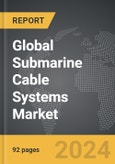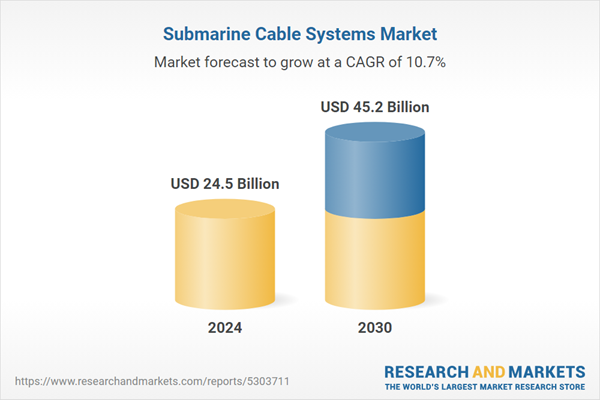The global market for Submarine Cable Systems was valued at US$24.5 Billion in 2024 and is projected to reach US$45.2 Billion by 2030, growing at a CAGR of 10.7% from 2024 to 2030. This comprehensive report provides an in-depth analysis of market trends, drivers, and forecasts, helping you make informed business decisions. The report includes the most recent global tariff developments and how they impact the Submarine Cable Systems market.
Segments: Application (Power Cables, Communication Cables); End-Use (Offshore Wind, Inter-Country & Island Connections, Offshore Oil & Gas).
Geographic Regions/Countries: World; United States; Canada; Japan; China; Europe (France; Germany; Italy; United Kingdom; and Rest of Europe); Asia-Pacific; Rest of World.
The analysts continuously track trade developments worldwide, drawing insights from leading global economists and over 200 industry and policy institutions, including think tanks, trade organizations, and national economic advisory bodies. This intelligence is integrated into forecasting models to provide timely, data-driven analysis of emerging risks and opportunities.
Global Submarine Cable Systems Market - Key Trends and Drivers Summarized
How Are Submarine Cable Systems Enabling Global Connectivity?
Submarine cable systems are extensive networks of cables laid under the ocean floor to facilitate high-speed data transmission and telecommunication between continents and countries. These cables, comprising optical fibers, are the backbone of global internet connectivity, carrying about 95% of international data traffic. Submarine cable systems support applications in telecommunications, data centers, financial trading, and cloud services, enabling seamless global communication, faster data transfer, and reliable connectivity. As the world becomes more digitally connected, the demand for efficient and high-capacity submarine cable systems has surged, driven by growing internet usage, cloud computing, and international data exchange.What Are the Key Segments in the Submarine Cable Systems Market?
Key cable types include unrepeatered and repeatered cables, with repeatered cables holding a larger market share due to their ability to transmit data over long distances with amplified signals. Applications cover communication, energy transmission, and scientific research, with communication representing a significant segment driven by the demand for high-speed, low-latency data transmission across continents. Components of submarine cable systems include cables, repeaters, branching units, and landing stations, with cables and repeaters representing critical segments due to their roles in ensuring signal integrity and long-distance data transfer.How Are Submarine Cable Systems Integrated Across Communication Networks?
In telecommunications, submarine cables serve as the primary medium for international voice, data, and video transmission, connecting internet service providers (ISPs), data centers, and cloud service providers globally. These cables enable seamless connectivity for businesses, governments, and consumers, supporting high-frequency trading, video streaming, and other data-intensive applications. In energy transmission, submarine cable systems connect offshore wind farms to onshore power grids, facilitating renewable energy integration and energy security. Scientific research also relies on submarine cables for seismic data collection and monitoring, helping researchers study oceanic conditions, climate change, and geological events in real-time.What Factors Are Driving the Growth in the Submarine Cable Systems Market?
The growth in the Submarine Cable Systems market is driven by several factors, including increasing demand for high-speed internet and data transmission, particularly with the expansion of cloud computing, content delivery networks (CDNs), and global data centers. Advancements in fiber optic technology, such as higher data capacity, improved signal amplification, and reduced latency, have supported broader adoption of submarine cable systems in international communication networks. The focus on digital transformation, fueled by 5G deployment and cross-border data exchange, has further fueled demand, as submarine cables provide reliable and secure infrastructure for global connectivity. Additionally, rising investments in undersea infrastructure projects, collaboration between telecom operators, and the need for energy-efficient data transmission have contributed to market growth, encouraging the development of new submarine cable routes and systems.Report Scope
The report analyzes the Submarine Cable Systems market, presented in terms of units. The analysis covers the key segments and geographic regions outlined below.Segments: Application (Power Cables, Communication Cables); End-Use (Offshore Wind, Inter-Country & Island Connections, Offshore Oil & Gas).
Geographic Regions/Countries: World; United States; Canada; Japan; China; Europe (France; Germany; Italy; United Kingdom; and Rest of Europe); Asia-Pacific; Rest of World.
Key Insights:
- Market Growth: Understand the significant growth trajectory of the Power Cables segment, which is expected to reach US$27.1 Billion by 2030 with a CAGR of a 10.1%. The Communication Cables segment is also set to grow at 11.7% CAGR over the analysis period.
- Regional Analysis: Gain insights into the U.S. market, valued at $6.9 Billion in 2024, and China, forecasted to grow at an impressive 10.1% CAGR to reach $6.9 Billion by 2030. Discover growth trends in other key regions, including Japan, Canada, Germany, and the Asia-Pacific.
Why You Should Buy This Report:
- Detailed Market Analysis: Access a thorough analysis of the Global Submarine Cable Systems Market, covering all major geographic regions and market segments.
- Competitive Insights: Get an overview of the competitive landscape, including the market presence of major players across different geographies.
- Future Trends and Drivers: Understand the key trends and drivers shaping the future of the Global Submarine Cable Systems Market.
- Actionable Insights: Benefit from actionable insights that can help you identify new revenue opportunities and make strategic business decisions.
Key Questions Answered:
- How is the Global Submarine Cable Systems Market expected to evolve by 2030?
- What are the main drivers and restraints affecting the market?
- Which market segments will grow the most over the forecast period?
- How will market shares for different regions and segments change by 2030?
- Who are the leading players in the market, and what are their prospects?
Report Features:
- Comprehensive Market Data: Independent analysis of annual sales and market forecasts in US$ Million from 2024 to 2030.
- In-Depth Regional Analysis: Detailed insights into key markets, including the U.S., China, Japan, Canada, Europe, Asia-Pacific, Latin America, Middle East, and Africa.
- Company Profiles: Coverage of players such as Fujitsu Limited, Hawaiki Cable Limited, Huawei Marine Networks Co., Limited, Mitsubishi Electric Corporation, NEC Corporation and more.
- Complimentary Updates: Receive free report updates for one year to keep you informed of the latest market developments.
Some of the 36 companies featured in this Submarine Cable Systems market report include:
- Fujitsu Limited
- Hawaiki Cable Limited
- Huawei Marine Networks Co., Limited
- Mitsubishi Electric Corporation
- NEC Corporation
- Nexans SA
- Nokia Corporation
- Prysmian Group
- Subcom, LLC
- Sumitomo Electric Industries, Ltd.
Tariff Impact Analysis: Key Insights for 2025
Global tariff negotiations across 180+ countries are reshaping supply chains, costs, and competitiveness. This report reflects the latest developments as of April 2025 and incorporates forward-looking insights into the market outlook.The analysts continuously track trade developments worldwide, drawing insights from leading global economists and over 200 industry and policy institutions, including think tanks, trade organizations, and national economic advisory bodies. This intelligence is integrated into forecasting models to provide timely, data-driven analysis of emerging risks and opportunities.
What’s Included in This Edition:
- Tariff-adjusted market forecasts by region and segment
- Analysis of cost and supply chain implications by sourcing and trade exposure
- Strategic insights into geographic shifts
Buyers receive a free July 2025 update with:
- Finalized tariff impacts and new trade agreement effects
- Updated projections reflecting global sourcing and cost shifts
- Expanded country-specific coverage across the industry
Table of Contents
I. METHODOLOGYII. EXECUTIVE SUMMARY2. FOCUS ON SELECT PLAYERSIII. MARKET ANALYSISIV. COMPETITION
1. MARKET OVERVIEW
3. MARKET TRENDS & DRIVERS
4. GLOBAL MARKET PERSPECTIVE
UNITED STATES
CANADA
JAPAN
CHINA
EUROPE
FRANCE
GERMANY
ITALY
UNITED KINGDOM
REST OF EUROPE
ASIA-PACIFIC
REST OF WORLD
Companies Mentioned (Partial List)
A selection of companies mentioned in this report includes, but is not limited to:
- Fujitsu Limited
- Hawaiki Cable Limited
- Huawei Marine Networks Co., Limited
- Mitsubishi Electric Corporation
- NEC Corporation
- Nexans SA
- Nokia Corporation
- Prysmian Group
- Subcom, LLC
- Sumitomo Electric Industries, Ltd.
Table Information
| Report Attribute | Details |
|---|---|
| No. of Pages | 92 |
| Published | April 2025 |
| Forecast Period | 2024 - 2030 |
| Estimated Market Value ( USD | $ 24.5 Billion |
| Forecasted Market Value ( USD | $ 45.2 Billion |
| Compound Annual Growth Rate | 10.7% |
| Regions Covered | Global |









